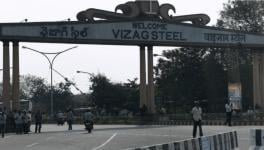From 2G to KG – India, Mega Scams and Neo-liberalism
Last week we had dealt with the broad issues in the KG Basin Gas scam, in which the Comptroller and Auditor General’s (CAG) findings are only one element. In this article, we will focus on what the CAG has noted in its draft report about the KG-6 block and the Production Sharing Contract (PSC) between Government of India and Reliance consortium. In this consortium, Reliance held 90 percent shares and Niko 10 percent, with Reliance being the operator. The key findings of CAG are:
- l Even though PSC envisaged a phase-wise vacation of the contract area for exploration under the New Exploration License (NELP), finally confining the operator to retain only the area from where commercial production takes place, the Directorate General of Hydrocarbons (DGH) and Ministry of Petroleum allowed Reliance to retain the entire exploration area as “discovery area” in gross violation of the contract.
- Reliance never submitted a comprehensive Field Development Plan as called for in the contract. Instead, it submitted an Initial Development Plan (IDP) with an outlay of $2.2 billion in 2004 and issued an Addendum to the IDP (AIDP) worth an additional $6.6 billion.
- Reliance started procurement action even before the Addendum was submitted or passed, indicating clearly that it took the Government approval for granted.
- Reliance added $746 million to its cost, which it had not incurred, as “estimated liabilities”, in violation of specific provisions of the contract and violation of all accounting norms.
- The presence of various sweetheart deals with its suppliers – most flagrant one being that for a Floating Production Vessel for $1.1 billion. It appears that this was a $26 million vessel, converted to a Floating Production Vessel taken by Reliance on a 10-year lease.
CAG has stated that it would like to go into each of the sub-contractor's prices and audit them further. Prima facie, a number of these contracts seem to be completely ad-hoc, based on single party offers, change of terms and scope during the course of the contract, etc.
If we look at the provisions of the PSC, there are two major classes of violations. One is Reliance keeping the total area given to it for exploration as discovery area, when the area of the major developed gas and oil fields there is less than five percent of the total.
The other is jacking up the capital cost. Reliance benefited in two ways – one, it recovered the inflated cost right in the beginning as “cost” petroleum; two, because of the nature of the profit sharing deal in PSC, it got a much higher share of the profit petroleum than it would have otherwise. Though CAG has not computed the total amount of scam as it wants to examine in more detail the inflation of costs, our rough estimate indicates the scam to be of the order of $10-12 billion. If we add to this, the additional area that Reliance has grabbed from keeping the entire exploration area for itself and therefore any future discoveries here would go to Reliance, the scam is indeed comparable to the 2G scam, if not bigger.
Converting Exploration Area to Discovery Area
As per the Draft Report, the total exploration area for KG Block 6 was 7,645 Km. This was an off-shore deep-water block and was awarded to Reliance in 2000 under NELP 1. Under the contract, Reliance was required to retain only 75 percent and 50 percent of the exploration area after Phase 1 and Phase 2 of the contract respectively. After Phase 3, it was supposed to retain only the area where it had made discoveries or developed gas or oil fields. Phase 1 was supposed to finish in June 2004 and Phase 2 by June 2005. Not only did Reliance not release any area, it claimed that the entire area should be considered discovery area as various 2D and 3D surveys showed that there were hydrocarbon deposits in the entire block. The Ministry of Petroleum and DGH accepted this claim and in February 2009 agreed that Reliance could keep the entire block as discovery area.
CAG has pointed out the following:
- Discovery in the contract was clearly based only on exploratory wells drilled and finding of petroleum at the surface, and not 2D and 3D seismic surveys.
- The wells sunk by Reliance, as visible from the map of wells drilled by 2010, showed that it covered only the north-west part of the block and therefore had not drilled any exploratory wells in other areas.
- Even the seismic surveys carried out – the 2D and 3D surveys – covered only a part of the block.
- Till the end of Phase 2, only 4.5 percent of the area had been designated as discovery area and therefore Reliance had no basis to claim that the entire area was “discovery area”.
- During Phase 2 of the contract period, DGH was on record asking Reliance to relinquish 25 percent of the area as per contract. It suddenly did a volte face later and decided that the entire exploration area could now be considered as discovery area.
Why is this issue important? This goes to the heart of the NELP and why production sharing contracts have been devised. It has been argued that National Oil Companies or the public sector does not have resources to explore the country's oil basins and therefore the case for inducting private capital. The entire argument for inducting private capital is for quick development of India's hydrocarbon resources. If any company takes a particular area for exploration, it must finish the exploration within a certain time period or release it back to the Government for awarding it to others. It cannot sit on top of an exploration area and hoard it for the future. That is why the clause of progressive release of exploration areas back to the Government. After Phase 3, the only area that the private party is to keep are those where it had already discovered oil or gas by drilling actual wells or had started commercial production. Everything else had to be given back.
Normally, when gas or oil is struck in an area, its nearby areas are also likely to have hydrocarbon deposits. The value of such areas would therefore go up for any subsequent auction. Hoarding such areas means that though the party considered has not spent the money it was required for exploration, it is still allowed to retain this area and explore it at leisure.
CAG has commented that clearly, the contractor never intended to relinquish any part of the exploration area and this was facilitated by DGH and the Ministry of Petroleum and Natural Gas (MoPNG) by “irregularly and incorrectly terming the entire contract area as 'discovery area', when drilling of wells, which is the primary requirement for 'discovery' and 'discovery area,' had not taken place in the major portion of the contract area.”
CAG has also pointed out that Reliance has similarly been granted another contract area as discovery area on the basis of discoveries when discoveries had not taken place in a major part of the contract area. As per CAG, this would open the floodgates for other private operators to follow suit and strike at the very heart of the PSC, “which mandates a time bound exploration process with relinquishment of undiscovered areas so that these can be re-auctioned for exploration and development by other willing parties.”
|
Phases and Dates |
Area to be relinquished |
|
Phase 1 end date June, 2004 |
25% of exploration area to be released |
|
Phase 2 end date June 2005 |
Another 25% or total of 50% to be released |
|
Phase 3 original end date June 2007 but was extended to July 2008 by MoPNG |
95% should have been released as only 5% of the area had discoveries |
|
February 2009 |
Ministry Allows entire exploration area to be considered discovery area even though Reliance had not drilled wells in the rest 95% of the area as called for in the PSC |
For all the discoveries, the PSC calls for a detailed appraisal programme and an appraisal report which identifies the boundaries of the hydrocarbon bearing block, the recoverable petroleum or gas. It is only after this that the contractor can move for claiming a commercial discovery and development of the field. In the case of KG-6 Block, Reliance skipped the appraisal part and went straight way to commercial discovery. As the appraisal report is the basis of the capital expenditure, this meant that all the capital expenditure being incurred had very little basis. The major cost escalation claimed for the D1-D3 area thus had no appraisal report. All the cost escalations and plans for expansion of production from 40 MMSCD to 80 MMSCD was done without a detailed appraisal of the discovery.
This was not the only issue. In the case of two other discoveries – D5 and D 18 – no proposals for appraisal have been received even after seven and six years, respectively. The PSC requires that if for three years the contractor does not submit an appraisal programme, the contractor shall relinquish its rights to develop such discovery and this area should be excluded from the contract area. Again, in spite of such blatant violation of the contract, no action has been taken by the Government and Reliance continues to hold all the original exploration area and the development rights.
Why is Reliance not exploring the contract area as it had proposed and why does it want to hold on to this entire area? Oil and gas exploration is costly business. If you strike oil or gas, as Reliance did, it would like to put its money in development of the field and getting its money out as quickly as possible. Moreover, if oil or gas has been struck, raising money in the capital market is easy, particularly given the nature of the one-sided production sharing contract that the Government of India has awarded. For Reliance, the game was simple, use the D1-D3 discovery, and the oil discovery in D6-MA-1 to bring in capital and focus on their development. Given the sweetheart deals and the cooking of the contracts as we shall detail later, this was creating capital out of market borrowings and then siphoning this from the top by inflating capital costs. Reliance did not have to spend any of their own money in this game, only cook the books.
While Reliance was looking for easy capital to finance its oil and gas field development, it did not want to relinquish the exploration area. It did not even want to put in money for the other 16 discoveries apart from D1-D3 and D6-MA-1. However, it is hot property in the oil market, and therefore Reliance wanted to retain the entire area of the D6 Block for future exploration and not relinquish it to the Government for auctioning again, as called for in the contract and envisaged under NELP.
CAG's draft report provides enough details to show how both DGH and MoPNG conspired with Reliance to keep the entire exploration area. CAG has indicted VK Sibal by name in the report and has also called for holding other concerned officials accountable for this. As we had noted in our previous article, VK Sibal has been under the CBI scanner for two years without any concrete steps being taken against him. However, the scale of this manipulation of the contract is not possible without the support of the Ministry concerned, not simply DGH and Sibal.
The proximity of Murli Deora, the former Petroleum Minister and now Minister, Corporate Affairs, to the Ambanis is well-known. The Petroleum Ministry's role in this manipulation is clear. A thorough probe in the role of the Ministry and the Minister is necessary, pending which Deora should resign from the Cabinet.
The other important issue is how much did the Government lose by the entire contract area having been designated as discovery area? CAG's draft report states that this is a huge loss as the Government could have re-auctioned this area and it would have fetched a very high price because of its proximity to known hydrocarbon bearing areas. That is why blocks near Bombay High had fetched high value in earlier auctioning. More important, blocks have been awarded to private parties in order to speed up gas and oil discoveries.
The question is what will the Government do about this? The response of Jaipal Reddy, the current Minister of Petroleum makes clear that the UPA is in a stone-walling mode, reminiscent of its 2G defence. However, irrespective of who is guilty of favours to Reliance, what prevents the UPA Government of making a simple statement – if the PSC has been violated, the Government will ensure that Reliance will not be able to gain from such violations. Why does the Government not simply say we are exploring means of taking back the extra area beyond 'discovered' and 'development' areas from Reliance? That way, it would at least do some damage control.
This however, is almost impossible for Manmohan Singh Government to do. Unlike Brazil and Venezuela, who have used their hydrocarbon and other natural resources to bank-roll pro-poor and anti-poverty measures, the trajectory of this government has been to use all natural resources such as spectrum, oil and gas, coal, iron ore, etc. to bank-roll the capitalist class. This is the core of economic policies of the Congress-led UPA Government. This is neo-liberalism at its ugliest.
(In the next article, we will explore the nature of the sweetheart deals entered into by Reliance and its sub-contractors.)
Get the latest reports & analysis with people's perspective on Protests, movements & deep analytical videos, discussions of the current affairs in your Telegram app. Subscribe to NewsClick's Telegram channel & get Real-Time updates on stories, as they get published on our website.
























